On Total Vertex Irregularity Strength of Hexagonal Cluster Graphs
Abstract
For a simple graph G with a vertex set V(G) and an edge set E(G), a labeling f : V(G)∪E(G)⟶{1,2, ⋯, k} is called a vertex irregular total k − labeling of G if for any two different vertices x and y in V(G) we have wt(x) ≠ wt(y) where wt(x) = f(x) + ∑u∈V(G)f(xu). The smallest positive integer k such that G has a vertex irregular total k − labeling is called the total vertex irregularity strength of G, denoted by tvs(G). The lower bound of tvs(G) for any graph G have been found by Baca et. al. In this paper, we determined the exact value of the total vertex irregularity strength of the hexagonal cluster graph on n cluster for n ≥ 2. Moreover, we show that the total vertex irregularity strength of the hexagonal cluster graph on n cluster is (3n2 + 1)/2.
1. Introduction
A graph labeling is an assignment of integers from 1 to n, for the vertices, edges, or both. Graph labelings have been used in many applications like communication network addressing, software testing, information security, technology and sports tournament scheduling, and coding theory problems including the design of good radar location codes, missile guidance codes, and convolution codes.
We consider the finite undirected graph G without loops and multiple edges with vertex set V(G) and edge set E(G). The degree of a vertex x is the number of edges that have x as an endpoint, and the set of neighbors of x is denoted by N(x). If the domain of the labeling function f(x) is the vertex set or the edge set, the labeling is called, respectively, vertex labeling or edge labeling. If the domain is V(G)∪E(G), then we call the labeling a total labeling.
A labeling f : E(G)⟶{1, 2, 3, ⋯, k} is called an edge k − labeling of G. The associated vertex weight of a vertex x ∈ V(G) under an edge k − labelingf is defined as wt(x) = ∑v∈N(x)f(xv). Chartrand et al. [1] introduced an edge k − labeling of a graph G such that wt(x) ≠ wt(y) for all vertices x, y ∈ V(G) with x ≠ y. Such labelings were called irregular assignments, and the irregularity strength s(G) of a graph G is known as the minimum k for which G has an irregular assignment using labels at most k. The irregularity strength s(G) can be interpreted as the smallest integer k for which G can be turned into a multigraph G′ by replacing each edge by a set of at most k parallel edges, such that the degrees of the vertices in G′ are all different.
In this paper, we consider for a total k − labeling of G, that is, f : V(G)∪E(G)⟶{1, 2, 3, ⋯, k}. The associated vertex weight of a vertex x ∈ V(G) under a total k − labelingf is defined as wt(x) = f(x) + ∑v∈N(x)f(xv). A total k − labelingf is defined to be a vertex irregular total k − labeling of G if for every two different vertices x and y of G, wt(x) ≠ wt(y). The minimum positive integer k for which G has a vertex irregular total k − labeling is called the total vertex irregularity strength of G, denoted by tvs(G). In Figure 1, there are a two total labeling of P4, one of is a vertex irregular total 3-labeling of P4 and the other is a vertex irregular total 2-labeling of P4. However, P4 does not have a vertex irregular total vertex 1-labeling. Such that the minimum positive integer k for which P4 has a vertex irregular total k − labeling is 2, or the total vertex irregularity strength of P4 is 2.


Baca et al. [2] in 2007 started to investigate the total vertex irregularity strength of a graph, an invariant analogous to the irregularity strength for total labelings. There are not many graphs for which the exact values of their total vertex irregularity strength are known. Baca et al. [2] have determined the total vertex irregularity strengths for some classes of graphs, namely, cycles, stars, and prisms. Nurdin et al. have determined the total vertex irregularity strengths of a disjoint union of t copies of a path [3], tree graphs [4], and caterpillar graph [5]. Nurdin and Kim have determined the total vertex irregularity strength of splitting graphs of stars [6].
In this paper, we determine exact value of the total vertex irregularity strength of the hexagonal cluster graph with n cluster for n ≠ 2.
2. Hexagonal Cluster Graph
In this section, we give the definition of hexagonal cluster graphs. The hexagonal cluster graph with n ≥ 2 cluster, denoted by HC(n), where HC(1) isomorphs to C6, is obtained by adding as many as 6(n − 1) cycle C6 on the outer path of HC(n − 1). Figure 2 demonstrates hexagonal cluster graphs HC(2), HC(3), and HC(4).
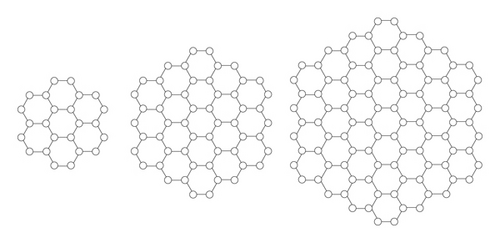
Some interconnection networks are designed, and some are borrowed from nature. For example, hypercubes, complete binary trees, butterflies, and torus networks are some of the designed architectures. Grids, hexagonal networks, honeycomb networks, and diamond networks, for instance, bear resemblance to atomic or molecular lattice structures. They are called natural architectures. The advancement of large scale integrated circuit technology has enabled the construction of complex interconnection networks. Besides that, the hexagonal cluster graphs have been studied as models of organic compounds build up entirely from benzene rings, social networks, and wireless sensor networks. Graph theory provides a fundamental tool for designing and analyzing such networks [7–11].
In [2], Baca et al. studied the lower bound of tvs(G) for any graph G as follows.
Theorem 1. If p is the number of vertices of any graph G, δ is the minimum degree of vertex, and Δ is the maximum degree of vertex of G, then
3. Results and Discussion
In this paper, we have proved that the total vertex irregularity strength of the hexagonal cluster graph (network) with n cluster is equal to its lower bound in Theorem 1.
Theorem 2. For n ≥ 2, we have
Proof. Since the number of vertices of HC(n) is 6n2, the minimum degree of vertex is 2 and the maximum degree of vertex is 3; by using (1) in Theorem 1, we found that
To find that tvs(HC(n)) ≤ (3n2 + 1)/2, we have to construct a vertex irregular total k − labeling on HC(n) where k = (3n2 + 1)/2 as follows.
Note that there are n layers in HC(n). Layer i is denoted by Li. For illustration, in Figure 3, there are 3 layers in HC(3).
In L1, there is an outer cycle C12n−6 of HC(n) which consists of 6n vertices of degree 2 denoted by xi(i = 1, 2, ⋯, 6n), 6(n − 1) vertices of degree 3 denoted by yj(j = 1, 2, ⋯, 6(n − 1)), and 12n − 6 edges denoted by et(t = 1, 2, ⋯, 12n − 6).
Now, consider all vertices and all edges in the outer cycle C12n−6 of HC(n) sequentially.
To label some of vertices and all edges in L1, we use Algorithm 1 as follows.
To label all of edges in Lt for 2 ≤ t ≤ n − 1 and for 3 ≤ i ≤ 2n − 3 define
All of edges of HC(n) are already labeled, but vertices have not labeled yet. Next, label all of vertices using the following method. The temporary weight of a vertex x is the number of label of all edges incident tox, denoted by w(x). For example, the temporary weight of a vertex x in Figure 4 is 8.
Order the temporary weight of all vertices and rename them by such that For i = 2, 3, ⋯, 6n, define
Based on equation (6), we have that
Besides that, from Algorithms 1 and 2, we can see that
Based on Statements (7) and (8), we conclude that the function construction with Algorithms 1 and 2 is a total vertex irregular k − labeling on HC(n) where k = (3n2 + 1)/2. This shown as follows:
Based on equations (3) and (9), we find equation (2), i.e., tvs(HC(n)) = (3n2 + 1)/2.
As illustration, we shall use Algorithms 1 and 2 to construct a total vertex irregular 25-labeling on HC(4). The first step, all the vertices and all the edges on the outer cyrcle C42 of HC(4) are named sequentially as in Figure 5.
Now, we use Algorithm 3 to label some of vertices and all edges in L1 as follows.
For 3 ≤ I ≤ 5, using equations (4) and (5), we have S3 = 24.3–(3/2)(32 − 1) = 60, S4 = 24.4–(3/2)42 = 72, and S5 = 24.5 − (3/2)(52 − 1) = 84.
Then, use Algorithm 4 to label all edges in L2 and L3, as follows.
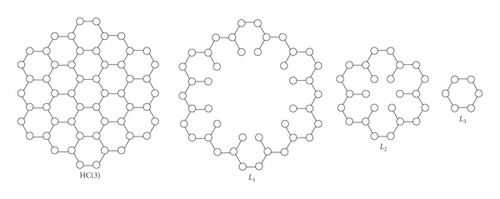
-
Algorithm 1: Algorithm for labeling all edges of the outer cycle of L1.
-
Step 1. For i = 1 + 3(k − 1) where k = 1, 2, ⋯, 2n, label e′, e″, and xi with (i + 2)/3 where e′ and e″ are edges incident to vertex xi
-
Step 2. For i = 1 + 3(k − 1) where k = 1, 2, ⋯, 2n, label edges between xi and xi+1by f(xi) + 1 except for the labeling edges in Step 1
-
Step 3. Label all edges between x1 and x6n−2 by f(x6n−2) + 1 = 2n + 1
-
Step 4. Label the remaining edges of L1 by 4n − 3
-
Algorithm 2: Algorithm for labeling all other edges in HC(n).
- K2t−1=(S2t−1+2−K2t−2)/3,
Step A. Label all of edges of the outer cycle in Lt for 2 ≤ t ≤ n − 1 by where K2 = 4n − 3
-
Step B. Label all of the remaining edges from Lt for 2 ≤ t ≤ n − 2 by K2t = (S2t + 2 − 2K2t−1)/2
-
Step C. Label all of the remaining edges in HC(n) by (3n2 + 1)/2

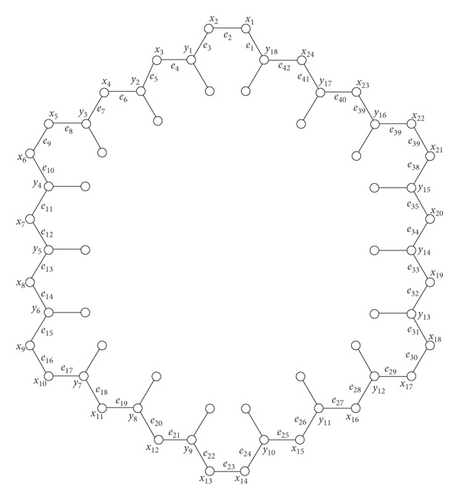
-
Algorithm 3: Algorithm for labeling all edges of the outer cycle of L1 of HC(4).
-
Step 1. For i = 1 + 3(k − 1) where k = 1, 2, 3, 4, 5, 6, 7, 8, label e′, e″, and xi with (i + 2)/3 where e′ and e″ are edges incident to vertex xi (see Figure 6)
-
Step 2. For i = 1 + 3(k − 1) where k = 1, 2, 3, 4, 5, 6, 7, 8, label edges between xi and xi+1 by f(xi) + 1 except for the labeling edges in Step 1
-
Step 3. Label all edges between x1 and x22 by f(x24) + 1 = 9 except for the labeling edges in Step 1 (see Figure 7)
-
Step 4. Label the remaining edges of L1 by 13 (see Figure 8)
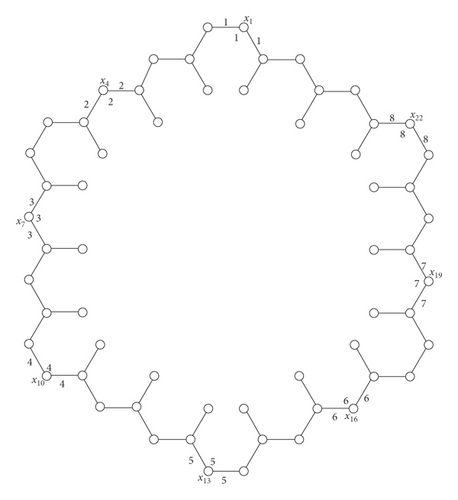
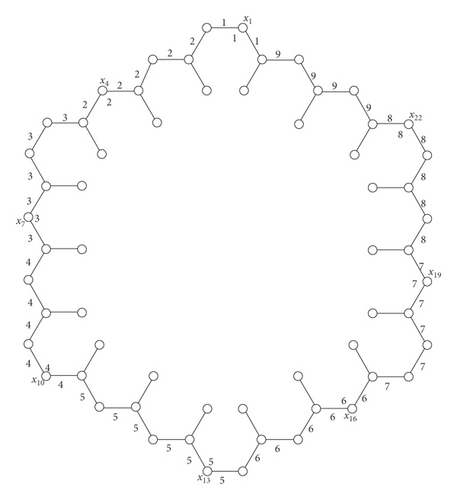
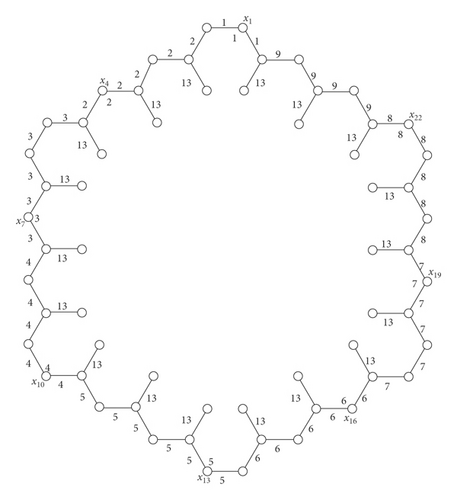
-
Algorithm 4: Algorithm for labeling all other edges in HC(4).
-
Step A. Label all edges of the outer cycle in L2 by using Algorithm 2, i.e., K3 = (S3 + 2 − K2)/3 where K2 = 13, i.e., K3 = (60 + 2 − 13)/3 = 17 (see Figure 9) and all edges of the outer cycle in L3 by K5 = (S5 + 2 − K4)/3 = (84 + 2 − 20)/3 = 22 (see Figure 10)
-
Step B. Label all of the remaining edges from L2 by using Algorithm 2, i.e., K4 = (S4 + 2 − 2K3)/2 = (72 + 2 − 2.17)/2 = 20 (see Figure 11)
-
Step C. Label all of the remaining edges in HC(4) by (3.42 + 1)/2 = 25 (see Figure 12)
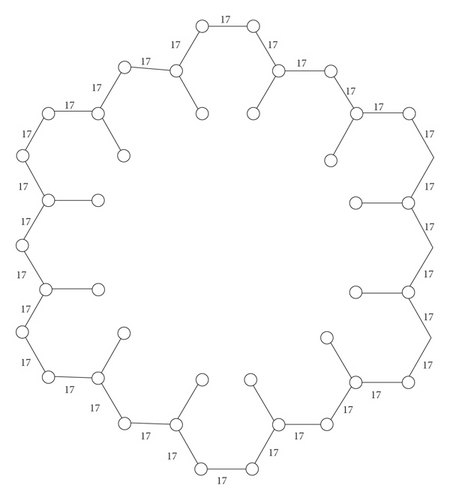
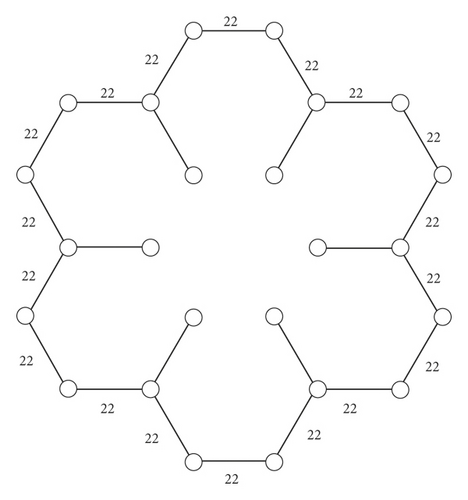
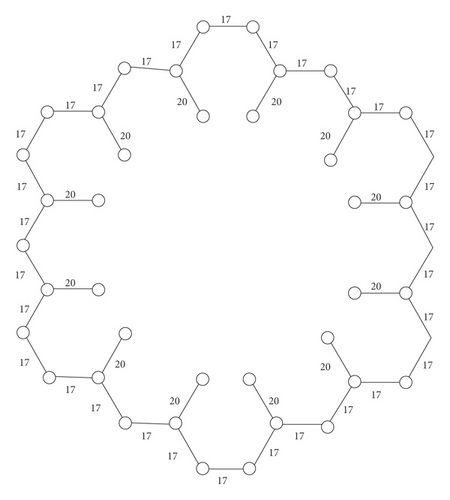
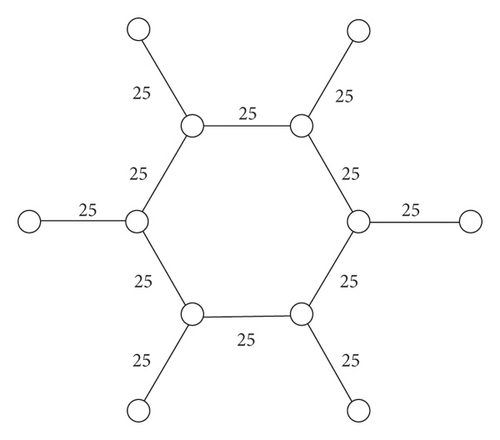
4. Conclusions
In this paper, we obtained the precise values for the total vertex irregularity strength of the hexagonal cluster graphs HC(n), for all n ≥ 2. Furthermore, we show that the hexagonal cluster graphs HC(n) is an example that the lower bound in \cite{BJMR07} is sharp. In the future, we are interested in computing the exact value for the total vertex (or edge) irregularity strength of grids, hexagonal networks, and honeycombs networks.
Conflicts of Interest
The author(s) declare that they have no conflicts of interest regarding the publication of this paper.
Acknowledgments
This research was supported by the Basic Science Research Program, National Research Foundation of Korea, Ministry of Education, (NRF-2018R1D1A1B07049584) and Basic Research Superior College, Directorate of Research and Community Service, Ministry of Research, Technology and Higher Education, Republic of Indonesia (007/SP2H/AMD/LT/DRPM/2020).
Open Research
Data Availability
The data used to support the findings of this study are included within the article.




